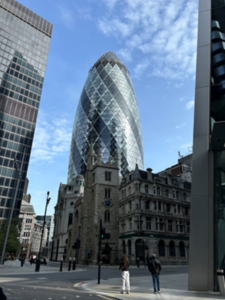
by Jessica Williams, Class of 2017
Photos by the author unless noted
London offers an architectural assortment—from the very old to the very new, as well as the adaptively reused. Yet it is surprisingly difficult to find regularly scheduled architecture tours. There are plenty of tours detailing the area’s rich history, but even tours of specific buildings (e.g., Westminster Abbey, St Paul’s Cathedral) tend to emphasize the events that took place in them (bombings, weddings) or the people buried on the premises, rather than the buildings themselves.
I offer two enthusiastic recommendations that are exceptions: Seeing Architecture and a tour of the Barbican.
Seeing Architecture has a handful of tours that present architecture in the buildings’ social and historical context. It is a one-man show run by Ross Logie, a practicing architect with passion for the city. I took his most popular tour on the financial district, the City of London. It offers a wonderful mix of iconic, contemporary structures as well as Victorian, Neoclassical, and Baroque buildings.
I was eager to learn about the contemporary ones—the ones with funny shapes and cute names (Gherkin, Walkie-talkie), designed by “starchitects” (e.g., Foster, Piano, Rogers, Viñoly). Local regulations require protected views of important historical buildings, especially St Paul’s Cathedral, from a range of vantage points. This explains some of the unusual shapes of these new buildings, for example, the Leadenhall Building (aka the Cheese grater), designed by Richard Rogers.

Just adjacent is another Rogers design, the very post-modern Lloyds Building. Like the Centre Pompidou, all the “guts” are on the outside. Richards hoped this would make it easier to repair and upgrade the building. Ironically, in 2011, the building was awarded Grade I status, similar to our landmarking, although buildings are eligible after just 25 years, which means it can no longer be changed at all. Fans of post-modernism will also appreciate Number One Poultry designed by James Stirling. Logie explains how this site almost hosted a Miesien box and grand plaza until the local community rose up in revolt at the prospect.



The tour includes several lovely churches from the masters of the English Baroque style. I was surprised at how much the Baroque morphed in its travel from Italy yet remained somehow recognizable. Included is Christopher Wren’s serene St. Stephen Walbrook, whose dome was supposedly a rehearsal for his design of St. Paul’s, as well as Nicholas Hawksmoor’s quirky, uniquely sculptural St. Mary Woolnoth, a personal favorite.

Adaptive reuse fans will appreciate the very Victorian Leadenhall Market, once a meat market, now home to tony shops and restaurants. There is even a special treat for CAC docents: London’s very first building supported by a metal frame. Holland House, clad in beautiful ceramic tiles, was built in 1916, more than 30 years after W.B. Jenney’s Home Insurance Building.


This eclectic mix of buildings makes the City of London my favorite of the 32 administrative districts in Greater London. It is unusual in that it is run by a corporation of wealthy financial institutions that has existed since the time of William the Conqueror. It is approximately one square mile, corresponding to the Roman city, Londinium.
The City is also the site of my second tour recommendation. The Barbican Estate is a residential development located in an area that was leveled during the Blitz. After the war, the Corporation originally proposed the construction of high-rise buildings to house financial institutions, but the post-war ethos favored a more socially conscious use of their funds. Instead, they bankrolled the Barbican. Designed and built between 1965 and 1976, it comprises more than 2000 apartments and town homes, including three huge towers, which for many years were the tallest structures in the city.

This was social (public) housing, though not the typical council housing found elsewhere. The target audience was young, middle-class professionals. The project was handed to a young design team with relatively little experience: Chamberlin, Powell and Bon. Although the estate is often described as Brutalist because of the use of raw concrete, the team drew on many sources of inspiration, including ancient Rome, Renaissance piazzas, as well as space age and Scandinavian design. In fact, raw concrete was never in the plan. Rather, the buildings were to be clad in polished marble and mosaic tiles. But the project went over budget, and the corporation tightened the purse strings.

In the 1980s, the Thatcher administration offered residents of social housing the Right to Buy. Many at the Barbican did so and then sold their units at much higher prices. The result is that now only the wealthy can afford to buy homes there. The Barbican offers a fascinating 90 minute tour of the estate that provides insight into the history and design of this planned community.
CLICK HERE for more stories on The Bridge.


Super interesting–thanks, Jessica!
Thanks Jessica – putting these on my list!
A great line up. Thank you.
Very interesting. Thanks, Jessica, both for the story and the pictures. Makes we want to go back to London yet again.
Great info and very interesting! Thanks Jessica!
Looks like I need to add London to my travel list…thanks for so many insights and wonderful photos!
Suzy Ruder
Thanks for the tips about architectural tours and the photos. I have seriously underestimated the attractions of the City. Now I know better.
Tom
Wonderful article and photos, Jessica. I will definitely take those tours if a London trip is in my future.
Thank you, Jessica. Great information to file away.
Thank you, Jessica! Interesting comments and review. (I admire your writing style, too.)